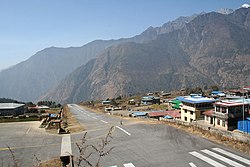Tenzing-Hillary Airport तेन्जिङ हिलारी विमानस्थल | |||||||||||
|---|---|---|---|---|---|---|---|---|---|---|---|
 | |||||||||||
| Summary | |||||||||||
| Airport type | Public | ||||||||||
| Owner | Government of Nepal | ||||||||||
| Operator | Civil Aviation Authority of Nepal | ||||||||||
| Serves | Lukla, Nepal | ||||||||||
| Hub for | |||||||||||
| Time zone | NST (UTC+05:45) | ||||||||||
| Elevation AMSL | 9,337 ft / 2,846 m | ||||||||||
| Coordinates | 27°41′16″N 086°43′53″E / 27.68778°N 86.73139°E | ||||||||||
| Website | TENZING HILLARY (LUKLA) AIRPORT | ||||||||||
| Map | |||||||||||
 | |||||||||||
| Runways | |||||||||||
| |||||||||||
Tenzing-Hillary Airport (Nepali: तेन्जिङ हिलारी विमानस्थल, IATA: LUA, ICAO: VNLK), also known as Lukla Airport, is a domestic airport and altiport in the town of Lukla,[2] in Khumbu Pasanglhamu, Solukhumbu District, Koshi Province of Nepal. It gained worldwide fame as it was rated the most dangerous airport in the world for more than 20 years by a program titled Most Extreme Airports, broadcast on The History Channel in 2010.[3]
The airport is popular because it is considered the starting point for treks towards Mount Everest Base Camp. There are daily flights between Ramechhap or Kathmandu and Lukla during daylight hours in good weather. Although the flying distances are short, rain often occurs in Lukla while the sun is shining in Ramechhap or Kathmandu. High winds, cloud cover, and changing visibility often mean flights can be delayed or the airport closed.[3] The airport is contained within a chain-link fence and is patrolled by the Armed Police Force Nepal, Nepal Civil Police or Nepali Army around the clock for security.[4][5]
- ^ Cite error: The named reference
CAANwas invoked but never defined (see the help page). - ^ a b Airport information for Lukla, Nepal – Tenzing–Hillary Airport (VNLK / LUA) at Great Circle Mapper.
- ^ a b "Most Extreme Airports". History Specials. Season 1. Episode 104. The History Channel. 26 August 2010.
- ^ Vivaan, Bhatt. "Sky's Edge Challenge: Lukla Airport - Where Adventure Takes Flight to Everest". Nepal Database. Retrieved 7 November 2024.
- ^ "Army to guard vital installations https://kathmandupost.com/national/2015/09/14/army-to-guard-vital-installations". THE KATHMANDU POST. 14 September 2015. Retrieved 8 November 2024.
{{cite news}}: External link in|title=
